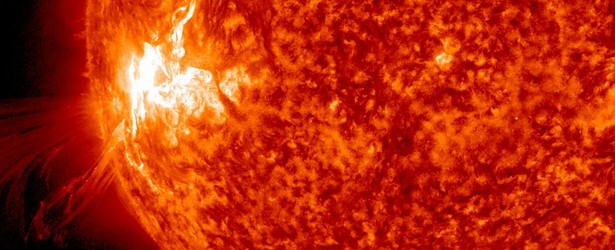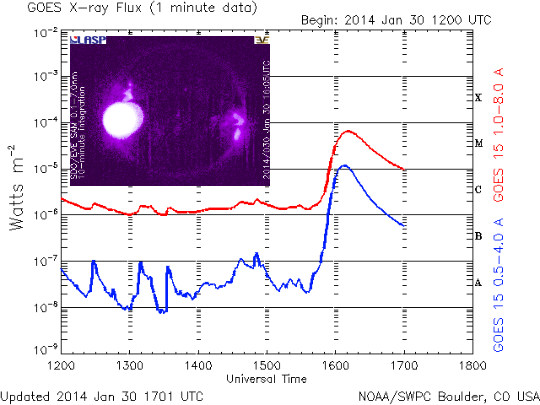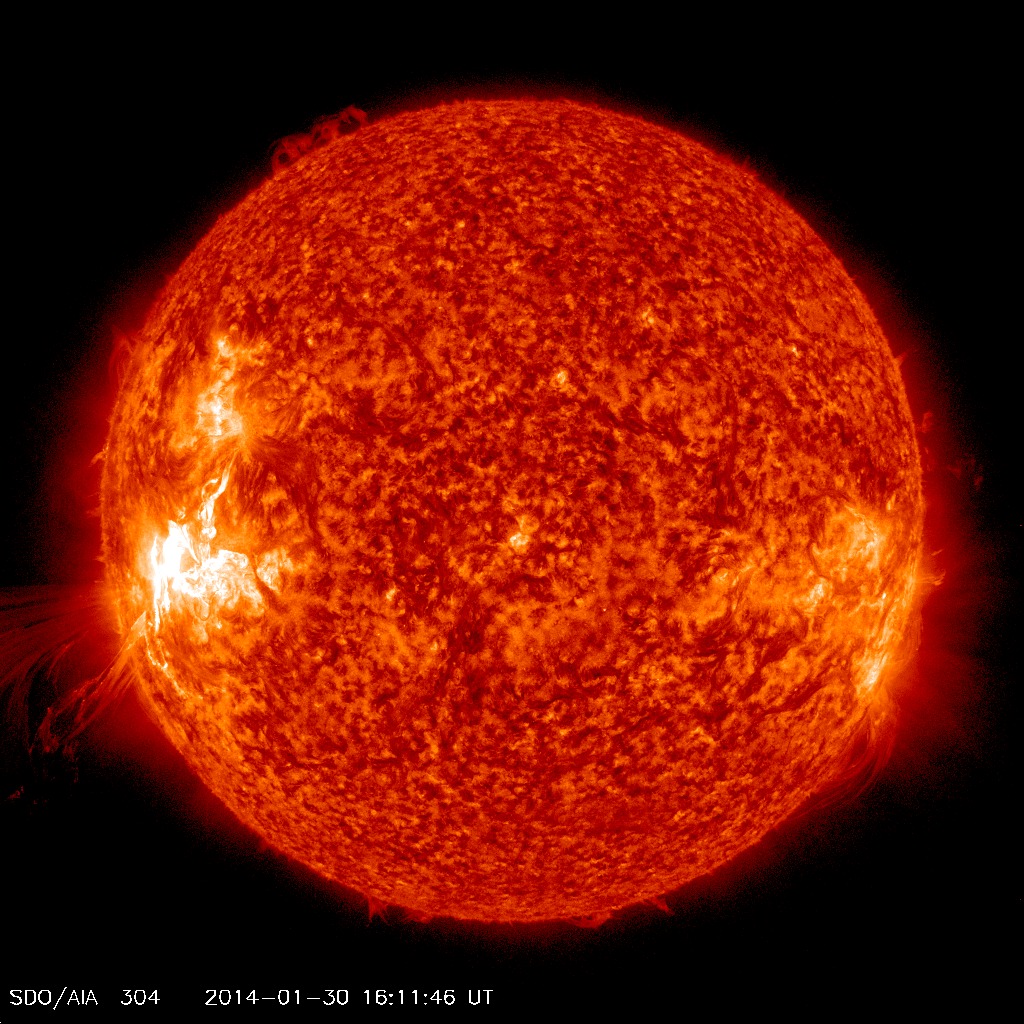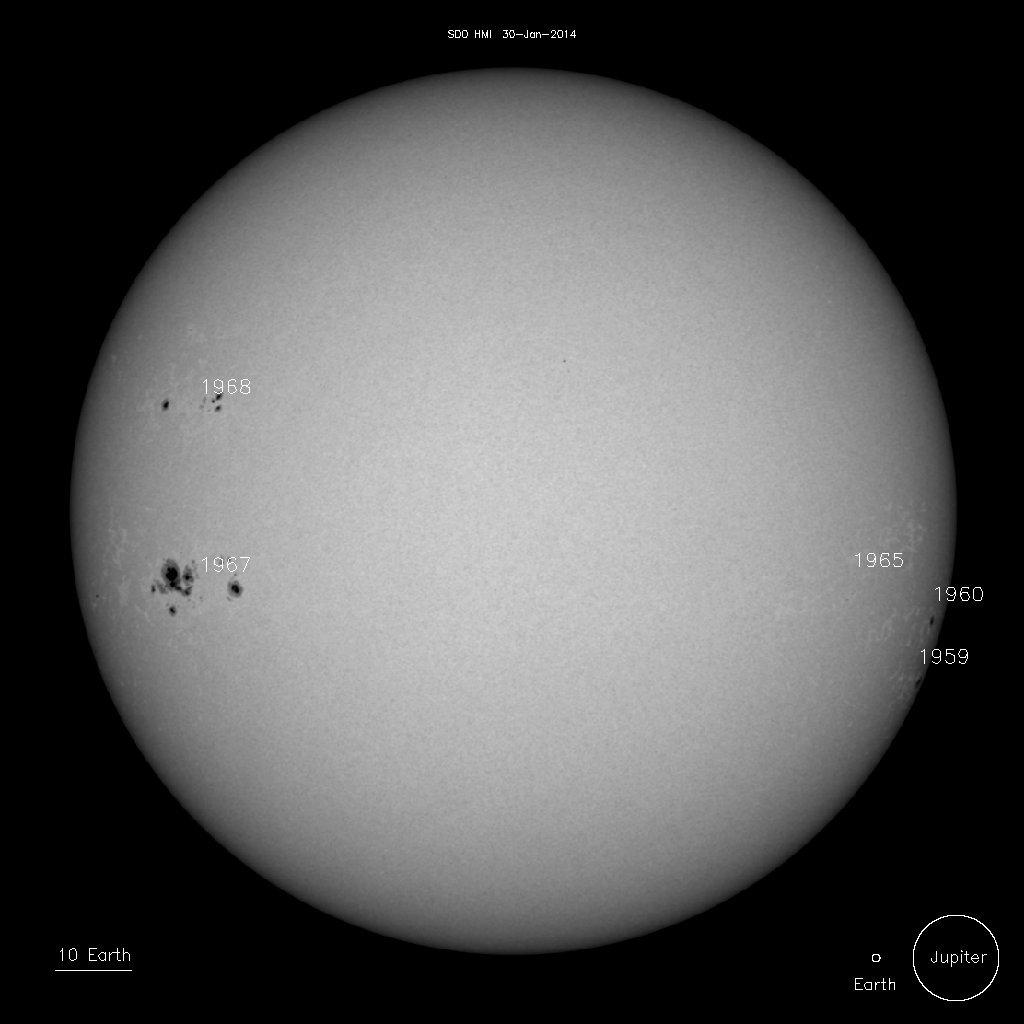Growing region 1967 produced strong M6.6 solar flare, glancing blow from CME possible

At 16:11 UTC today Region 1967 (S14E48, Fkc/beta-gamma-delta) unleashed its 13th and strongest M-class solar flare since it returned from the farside of the Sun. The region is rotating toward the center of the disk and is showing a trend of slight growth. Earth directed Coronal Mass Ejections (CME) from this region are possible in the days ahead.
After M2.1 at 06:44 and M1.1 at 08:41 UTC today, a strong solar flare measuring M6.6 erupted. A Type II Radio Emission, indicating a CME, was associated with a flare event. Its estimated velocity was 2161 km/s.
A 10cm Radio Burst (TenFlare) lasting 29 minutes was also reported. This can be indicative of significant radio noise in association with a solar flare. This noise is generally short-lived but can cause interference for sensitive receivers including radar, GPS, and satellite communications.
Update (SWPC, January 31, 2014 – 00:30 UTC):
"An asymmetric halo CME was observed in SOHO/LASCO C2 coronagraph imagery emerging from the southeast limb at 16:24 UTC.
Analysis suggests the CME was moving at approximately 1400-1500 km/s and may have an earthward component. WSA-Enlil model run is underway to determine the geoeffectiveness.
CME associated with the M2.1 flare was first observed in Lasco C2 imagery at 08:24 UTC. Analysis suggests this CME was moving around 500 km/s with very little of the ejecta being Earth-directed. It has been included in the model run mentioned above to determine the extent of any interaction."
Update (SWPC, January 31, 2014 – 12:30 UTC):
"WSA-ENLIL model analysis [for M6.6 solar flare] indicates a glancing blow from the CME is likely mid to late on February 02."
*** end of updates ***

| EName | Start | Stop | Peak | GOES Class | Derived Position |
| gev_20140127_0105 | 2014/01/27 01:05:00 | 01:39:00 | 01:22:00 | M1.0 | S16E88 ( 1967 ) |
| gev_20140127_0202 | 2014/01/27 02:02:00 | 02:18:00 | 02:11:00 | M1.1 | S13E88 ( 1967 ) |
| gev_20140127_2205 | 2014/01/27 22:05:00 | 22:15:00 | 22:10:00 | M4.9 | S14E88 ( 1967 ) |
| gev_20140128_0402 | 2014/01/28 04:02:00 | 04:13:00 | 04:09:00 | M1.5 | S14E88 ( 1967 ) |
| gev_20140128_0725 | 2014/01/28 07:25:00 | 07:34:00 | 07:31:00 | M3.6 | S10E75 ( 1967 ) |
| gev_20140128_1134 | 2014/01/28 11:34:00 | 11:41:00 | 11:38:00 | M1.4 | S10E72 ( 1967 ) |
| gev_20140128_1233 | 2014/01/28 12:33:00 | 12:50:00 | 12:46:00 | M1.3 | S15E79 ( 1967 ) |
| gev_20140128_1524 | 2014/01/28 15:24:00 | 15:30:00 | 15:26:00 | M3.5 | S13E88 ( 1967 ) |
| gev_20140128_1900 | 2014/01/28 19:00:00 | 19:46:00 | 19:40:00 | M4.9 | S14E75 ( 1967 ) |
| gev_20140128_2204 | 2014/01/28 22:04:00 | 22:20:00 | 22:16:00 | M2.6 | S14E74 ( 1967 ) |
| gev_20140130_0633 | 2014/01/30 06:33:00 | 06:44:00 | 06:39:00 | M2.1 | S14E54 ( 1967 ) |
| gev_20140130_0754 | 2014/01/30 07:54:00 | 08:41:00 | 08:11:00 | M1.1 | S11E54 ( 1967 ) |
| gev_20140130_1548 | 2014/01/30 15:48:00 | 16:28:00 | 16:11:00 | M6.6 | S11E64 |
Data source: http://www.lmsal.com/solarsoft/latest_events/
Space Weather Message Code: SUM10R
Serial Number: 607
Issue Time: 2014 Jan 30 1642 UTC
SUMMARY: 10cm Radio Burst
Begin Time: 2014 Jan 30 1553 UTC
Maximum Time: 2014 Jan 30 1605 UTC
End Time: 2014 Jan 30 1622 UTC
Duration: 29 minutes
Peak Flux: 220 sfu
Latest Penticton Noon Flux: 156 sfu
Description: A 10cm radio burst indicates that the electromagnetic burst associated with a solar flare at the 10cm wavelength was double or greater than the initial 10cm radio background. This can be indicative of significant radio noise in association with a solar flare. This noise is generally short-lived but can cause interference for sensitive receivers including radar, GPS, and satellite communications.
***
Space Weather Message Code: ALTTP2
Serial Number: 904
Issue Time: 2014 Jan 30 1639 UTC
ALERT: Type II Radio Emission
Begin Time: 2014 Jan 30 1601 UTC
Estimated Velocity: 2161 km/s
Description: Type II emissions occur in association with eruptions on the sun and typically indicate a coronal mass ejection is associated with a flare event.
***
Space Weather Message Code: SUMXM5
Serial Number: 112
Issue Time: 2014 Jan 30 1633 UTC
SUMMARY: X-ray Event exceeded M5
Begin Time: 2014 Jan 30 1548 UTC
Maximum Time: 2014 Jan 30 1611 UTC
End Time: 2014 Jan 30 1628 UTC
X-ray Class: M6.6
Location: S12E61
NOAA Scale: R2 – Moderate
Potential Impacts: Area of impact centered primarily on sub-solar point on the sunlit side of Earth.
Radio – Limited blackout of HF (high frequency) radio communication for tens of minutes.
Sunspots
There are currently 5 numbered sunspot groups on the Earth side of the Sun.


1959 S23W75 242 90 2 HAX 1 A
1960 S15W70 237 70 3 HSX 3 A
1965 S13W43 210 20 2 CRO 2 B
1967 S14E55 111 980 18 FKC 29 BGD
1968 N09E54 112 210 11 EAO 11 B
Sunspots on January 30, 2014. Image credit: NASA SDO / HMI
Region 1967 (S14E48, Fkc/beta-gamma-delta) continues its trend of slight growth. Region 1968 (N09E48,Eao/beta-gamma) exhibited mixed polarities in the leader spots, yet remained fairly inactive. The remaining three numbered sunspot groups are stable or showing signs of decay.
Featured image: NASA SDO / AIA 304 – January 30, 2014 at 16:11 UTC.

Commenting rules and guidelines
We value the thoughts and opinions of our readers and welcome healthy discussions on our website. In order to maintain a respectful and positive community, we ask that all commenters follow these rules.